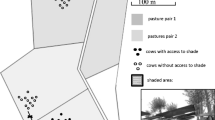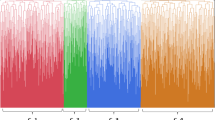Abstract
Records were obtained over a 3 year period from six Holstein dairy farms of 300 to 500 cows each in the Phoenix, Ariz. area. Dairies were selected on the basis of similar management practices, herd size, milk production and facilities (with the exception of cooling systems). Microclimatic modifications (two dairies each) were shade only (approximately 3.7 m2/cow), evaporative-cooled shades and low-pressure water foggers under the shades. Data were categorized by season of calving (spring, Feb.–May; summer, June–Sept.; and fall, Oct.–Jan.). Traits evaluated were calving interval, days open and services/conception. Calving interval was shortest for cows calving in the spring (378 days), intermediate in fall (382 days) and longest in summer (396 days). Similar seasonal trends were observed for days open (103, 103 and 119 days, respectively) and services/conception (1.54, 1.81 and 1.93, respectively). All differences between spring and summer were significant (P < 0.05). Calving interval and days open were less for evaporative-cooled groups (374 and 98 days, respectively), with no difference between shade only and foggers (391 and 392 days, 112 and 116 days, respectively). Services/conception were similar for all groups (1.72 to 1.79). A significant interaction between microclimate and season for services/conception could be interpreted as (i) smaller season differences for evaporative-cooled groups than for shade or foggers, or (ii) a change in the ranking of control and fogger groups during summer versus fall. Evaporative cooling was more effective than fogging for reducing the detrimental effects of seasonal high temperatures on fertility.
Similar content being viewed by others
References
Ansell RH (1981) Extreme heat stress in dairy cattle and its alleviation: A case report. In: Clark JA (ed) Environmental aspects of housing for animal production. Butterworths, London, pp 285–306
Armstrong DV, Wiersma F (1986) How to beat the heat in lactating dairy cows. Proceedings of Southwest Nutrition and Management Conference, Department of Animal Sciences, University of Arizona, pp 60–66
Flamenbaum I, Wolfenson D, Mamen M, Berman A (1986) Cooling dairy cattle by a combination of sprinkling and forced ventilation and its implementation in the shelter system. J Dairy Sci 69:3140–3147
Igono MO, Stevens BJ, Shanklin MD, Johnson HD (1985) Spray cooling effects on milk production, milk, and rectal temperatures of cows during a moderate temperate summer season. J Dairy Sci 68:979–985
Ingraham RH, Gillette DD, Wagner WD (1974) Relationship of temperature and humidity to conception rate of Holstein cows in subtropical climate. J Dairy Sci 57:476–481
Monty DE Jr, Wolff LK (1974) Summer heat stress and reduced fertility in Holstein-Friesian cows in Arizona. Am J Vet Res 35:1495–1500
Ryan DP, Armstrong D, Kopel E, Munyakazi L, Boland MP, Godke RA (1988) Effect of two different cooling systems in dairy cows in a warm, dry climate. J Dairy Sci [Suppl 1] 71:270
SAS/STAT (1988) User's guide, release 6.03 edition. SAS Institute Cary, N.C.
Shultz TA (1986) Corral manger misting heat stressed dairy cows. Proceedings of Southwest Nutrition and Management Conference, Department of Animal Sciences, University of Arizona, pp 67–73
Stott GH, Williams RJ (1962) Causes of low breeding efficiency in dairy cattle associated with seasonal high temperatures. J Dairy Sci 45:1369–1375
Stott GH, Wiersma F (1974) Response of dairy cattle to an evaporative cooled environment. Proceedings of International Environmental Symposium, Am Soc Agric Engr, pp 88–95
Stott GH, Wiersma F, Woods JM (1972) Reproductive health program for cattle subjected to high environmental temperatures. J Am Vet Med Assoc 161:1339–1344
Thatcher WW (1974) Effects of season, climate, and temperature on reproduction and lactation. J Dairy Sci 57:360–368
Wiersma F, Stott GH (1966) Microclimate for hot-weather stress relief of dairy cattle. Trans Am Soc Agric Engr 9:309–311
Wolfenson D, Flamenbaum I, Berman A (1988a) Dry period heat stress relief effects on prepartum progesterone, calf birth weight, and milk production. J Dairy Sci 71:809–818
Wolfenson D, Flamenbaum I, Berman A (1988b) Hyperthermia and body energy store effects on estrous behaviour, conception rate, and corpus luteum function in dairy cows. J Dairy Sci 71:3497–3504
Author information
Authors and Affiliations
Rights and permissions
About this article
Cite this article
Ray, D.E., Jassim, A.H., Armstrong, D.V. et al. Influence of season and microclimate on fertility of dairy cows in a hot-arid environment. Int J Biometeorol 36, 141–145 (1992). https://doi.org/10.1007/BF01224816
Received:
Revised:
Accepted:
Issue Date:
DOI: https://doi.org/10.1007/BF01224816




